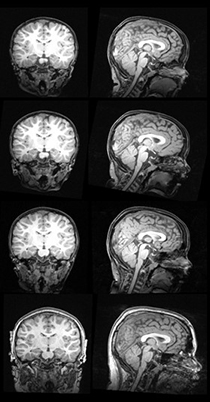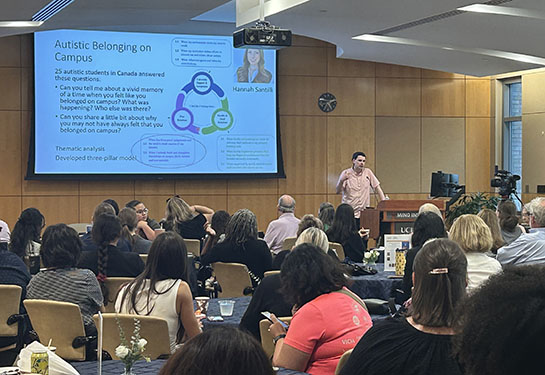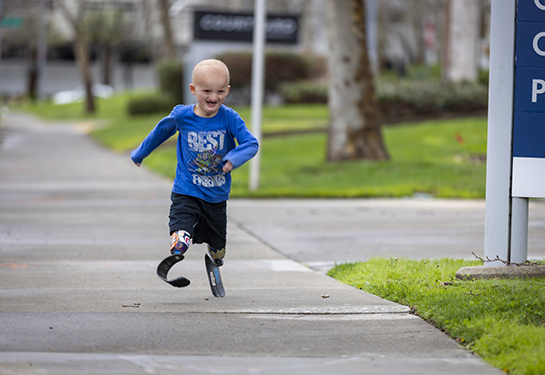Big brains and white matter: New clues about autism subtypes
UC Davis MIND Institute researchers tracked brain changes in children over many years using MRIs
This video is best viewed in Chrome or Firefox.
Two groundbreaking studies at the UC Davis MIND Institute provide clues about possible types of autism linked to brain structure, including size and white matter growth.
The research is based on brain scans taken over many years as part of the Autism Phenome Project (APP) and Girls with Autism, Imaging of Neurodevelopment (GAIN) studies. It shows the value of longitudinal studies that follow the same children from diagnosis into adolescence.

The researchers tracked brain growth and structure in hundreds of children from age 3 to age 12
“There is no other single site data set like ours anywhere,” said Christine Wu Nordahl, professor in the Department of Psychiatry and Behavioral Sciences, MIND Institute faculty member and co-senior author on both papers. “In one of the studies we have over 1,000 MRI scans from 400 kids, which is unheard of. It’s been 15 years of work to get here.”
Big brains: An autism subtype?
In the first study, published in Biological Psychiatry, the researchers used MRIs to track brain size (volume) in 294 children with autism and 135 children without autism between the ages of 3 and 12. In autistic children, they found evidence of larger brain size relative to height - or disproportionate megalencephaly - a subtype that has been linked to higher rates of intellectual disability and poorer overall prognosis.
Previous cross-sectional research had found that children with autism have larger brains at early ages, but no evidence of larger brains in later childhood. The widely accepted theory is that these brains “normalized” or shrank as the children grew up.
The MIND Institute study found that wasn’t the case. The children who had bigger brains at age 3 still had bigger brains at age 12. Why? Unlike most research, which studies different individuals at different time points, this research studied the same children longitudinally, or over time.
Also, unlike most other studies, this one includes children with significant intellectual disabilities. These were the children who tended to have the “big brain” form of autism.
David Amaral, co-senior author on both studies, suggested that the difference between this and previous research was that children with intellectual disability were left out of previous cross-sectional studies focused on older children.

David Amaral
“Bigger brain size in autism has been linked to lower IQ, and children with intellectual disabilities are harder to scan as they get older,” said Amaral, a distinguished professor of psychiatry and behavioral sciences and MIND Institute faculty member. “It’s a matter of sampling bias and the previous “dogma” appears to be an artefact of who got scanned when,” he explained.
Children under age 5 can be scanned while they’re asleep, but Nordahl and her team have created unique, innovative protocols that allow researchers to more easily scan older children with intellectual disabilities while they’re awake.
“It’s so critical that we include those aspects of the autism spectrum that most impact quality of life, such as intellectual disability, anxiety and verbal functioning.” said Joshua Lee, postdoctoral scholar at the MIND Institute and the lead author on the study. “It’s important to capture everyone who has autism, not just the ones who are easiest to get images from.”
White matter: Connecting the clinical dots
The second study, also published in Biological Psychiatry, linked changes in the brain’s white matter growth with autism traits in some children.
The researchers used a type of MRI scan called diffusion-weighted imaging, which allowed them to look at white matter regions, or tracts, in the brain. White matter provides the structural connections in the brain, allowing different regions to communicate with each other.
The study included 125 children with autism and 69 typically developing children who served as controls, between the ages of 2.5 and 7.
The researchers found that the development of the white matter tracts in the brain was linked to changes in autism traits. They observed slower development in children whose severity increased over time, and faster development in those with decreased severity over time.

Innovative Brain Scan Methods
The Autism Phenome Project and Girls with Autism, Imaging of Neurodevelopment studies rely on MRI scans of the same children – both with and without autism - over many years in order to track brain development. Scanning the brain of a young child is less challenging; it’s done while they’re asleep. But after about age 5, things change, especially for children with more severe intellectual disability.
“If you take a nonspeaking child with intellectual disability, it’s still fairly manageable to get them scanned when they’re sleeping, but as they get older and bigger, scanning during sleep gets really tricky,” said Christine Wu Nordahl, MIND Institute faculty member and neuroimaging expert. “We had to develop brand new methods to scan kids with lower IQ and verbal skills while they were awake.”
Nordahl and other MIND Institute researchers enlisted the help of behavior analysts — those doing autism therapy — and broke down the MRI process into many sections, starting with entering the building, to make it less scary.
“We use reinforcements specifically tailored to each child,” Nordahl said. “We talk to parents ahead of time about what motivates their child, which could be anything from pistachios to a cartoon character, and we use those to make the child more comfortable.”
Nordahl’s team uses a mock MRI machine that children can try out before their actual scans. When the child is in the MRI machine, they are also able to watch a movie or a show, and utilize weighted blankets, if desired.
“It’s very challenging to do this, but it’s worth it to ensure that our research includes the full spectrum of children with autism,” Nordahl said.
“From a biological standpoint, this emphasizes the role of white matter development in autism and autism symptoms,” said Derek Sayre Andrews, postdoctoral scholar at the MIND Institute and lead author on the paper. “We hope that in the future, measurements like this can identify children who would benefit from more intensive intervention – and serve as a marker to determine the effectiveness of an intervention for a particular child,” he said.
Changes in autism severity over time
The white matter research builds on a previous MIND Institute study, which found that while many children experience fairly stable levels of autism symptoms throughout childhood, a significant portion can be expected to increase or decrease in their symptom severity over time.
“This new analysis provides an important clue about the brain mechanism that may be involved in some of these changes,” said Amaral.
Studying sex differences
The studies are unusual not only because they include children with severe intellectual disability, but also because they include a larger number of girls, who tend to be under-represented in autism research.
“For the first time, we are able to have a large enough sample of girls, where we are able to evaluate their brain trajectories separate from boys to see how they’re different,” said Nordahl. “For example, we don’t see the big brain subtype as frequently in girls, but we do see subtle differences in how autistic girls’ brains are growing.”
Nordahl, who has also studied the role amygdala size may play in psychiatric challenges for young girls, noted that the MIND Institute’s longitudinal data set is likely to play a key role in many future studies about sex differences in autism.
“Collectively, I believe these studies are so important because they get us closer to a point where we can use our understanding of the underlying biology of autism to directly improve the quality of life for individuals in the autistic community,” Andrews said. “And that really is the ultimate goal of our research.”
Co-authors on “Longitudinal Evaluation of Cerebral Growth Across Childhood in Boys and Girls with Autism Spectrum Disorder” include Sally Ozonoff, Marjorie Solomon, Sally J. Rogers and Derek Sayre Andrews.
Funding for this study was provided by the National Institute of Mental Health (R01MH104438, R01MH103284, R01MH103371); the UC Davis MIND Institute Intellectual and Developmental Disabilities Research Center (U54HD079125); and Autism Center of Excellence (P50HD093079).
doi: https://doi.org/10.1016/ j.biopsych.2020.10.014
Co-authors on “A Longitudinal Study of White Matter Development in Relation to Changes in Autism Severity Across Early Childhood” include Joshua K. Lee, Danielle Jenine Harvey, Einat Waizbard-Bartov, Marjorie Solomon and Sally J. Rogers
Funding for this study was provided by the National Institute of Mental Health (R01MH104438 R01MH103284, R01MH103371). This project was also supported by the MIND Institute Intellectual and Developmental Disabilities Research Center (U54HD079125) and the MIND Institute Autism Research Training Program (T32MH073124).
doi: https://doi.org/10.1016/j.biopsych.2020.10.013.
The UC Davis MIND Institute in Sacramento, Calif. is a unique, interdisciplinary research, clinical, and education center committed to deepening scientific understanding of autism and other neurodevelopmental conditions. It is a highly collaborative center, bringing together families, researchers, clinicians, community leaders and volunteers with the common goal of developing more personalized, equitable, and scientifically proven systems of support and intervention. The institute has major research efforts in autism, fragile X syndrome, chromosome 22q11.2 deletion syndrome, attention-deficit/hyperactivity disorder (ADHD) and Down syndrome. More information about the institute and its Distinguished Lecturer Series, including previous presentations in this series, is available on the Web at mindinstitute.ucdavis.edu.



